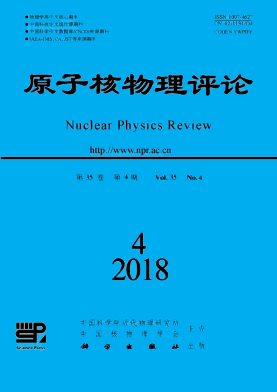|
[1]
|
WIRINGA R B, STOKS V G J, SCHIAVILLA R. Phys Rev C, 1995, 51:38. |
|
[2]
|
MACHLEIDT R. Phys Rev C, 2001, 63:024001. |
|
[3]
|
ENTEM D R, MACHLEIDT R. Phys Rev C, 2003, 68:041001. |
|
[4]
|
EPELBAUM E, KREBS H, MEINER U G. Phys Rev Lett, 2015, 115:122301. |
|
[5]
|
MAYER M G. Phys Rev, 1949, 75:1969. |
|
[6]
|
HAXEL O, JENSEN J H D, SUESS H E. Phys Rev, 1949, 75:1766. |
|
[7]
|
NAVRATIL P, VARY J P, BARRETT B R. Phys Rev Lett, 2000, 84:5728. |
|
[8]
|
BARRETT B R, NAVRATIL P, VARY J P. Prog Part Nucl Phys, 2013, 69:131. |
|
[9]
|
NAVRATIL P, QUAGLIONI S, STETCU I, et al. J Phys G:Nucl Part, 2009, 36:083101. |
|
[10]
|
ROUTH R, NAVRATIL P. Phys Rev Lett, 2007, 99:092501. |
|
[11]
|
ABE T, MARRIS P, OTSUKA T, et al. Phys Rev C, 2012, 86:054301. |
|
[12]
|
ROSENSTEEL G, DRAAYER J P, WEEKS K J. Nucl Phys A, 1984, 419:1. |
|
[13]
|
ROSENSTEEL G, ROWE D J. Phys Rev Lett, 1977, 38:10. |
|
[14]
|
ROWE D J. Rep Prog. Phys, 1985, 48:1419. |
|
[15]
|
BAHRI C, ROWE D J. Nucl Phys A, 2000, 662:125. |
|
[16]
|
BOHR A, MOTTELSON B R. Nuclear Structure[M]. New York:Benjamin, 1969. |
|
[17]
|
ELLIOTT J P. Proc Roy Soc A, 1958, 245:128. |
|
[18]
|
ELLIOTT J P, HARVEY M. Proc Roy Soc A, 1963, 272:557. |
|
[19]
|
BAHRI C, DRAAYER J P, MOSZKOWSKI S. Phys Rev Lett, 1992, 68:2133. |
|
[20]
|
ZUKER A, RETAMOSA J, POVES A, et al. Phys Rev C, 1995, 52:R1741. |
|
[21]
|
ROWE D J. AIP Conf Proc, 2013, 1541:104. |
|
[22]
|
LAUNEY K D, DYTRYCH T, DRAAYER J P. Prog Part Nucl Phys, 2016, 89:101. |
|
[23]
|
DYTRYCH T, LAUNEY K D, DRAAYER J P, et al. Phys Rev Lett, 2013, 111:252501. |
|
[24]
|
DREYFUSS A C, LAUNEY K D, DYTRYCH T, et al. Phys Lett B, 2013, 727:511. |
|
[25]
|
DYTRYCH T, SVIRATCHEVA K D, DRAAYER J P, et al. J Phys G:Nucl Part Phys, 2008, 35:123101. |
|
[26]
|
ELLIOTT J P. Proc Roy Soc A, 1958, 245:562. |
|
[27]
|
LAUNEY K D, DREYFUSS A C, DRAAYER J P, et al. J Phys:Conf Ser, 2014, 569:012061. |
|
[28]
|
ROSENSTEEL G, DRAAYER J P. Nucl Phys A, 1985, 436:445. |
|
[29]
|
ROWE D J. Phys Rev, 1967, 162:866. |
|
[30]
|
ROWE D J, THIAMOVA G, WOOD J L. Phys Rev Lett, 2006, 97:202501. |
|
[31]
|
DREYFUSS A C, LAUNEY K D, DYTRYCH T, et al. Phys Rev C, 2017, 95:044312. |
|
[32]
|
TOBIN G K, FERRISS M C, LAUNEY K D, et al. Phys Rev C, 2014, 89:034312. |
|
[33]
|
LAUNEY K D, DYTRYCH T, DRAAYER J P, et al. Symmetry Adapted No-core Shell Model for Light Nuclei, in Proceedings of the 5th International Conference on Fission and Properties of Neutron-rich Nuclei, ICFN5, November 4-10, 2012, Sanibel Island, Florida, eds. J. H. Hamilton and A. V. Ramayya, Singapore:World Scientific, 2013. |
|
[34]
|
EKSTRÖM A, BAARDSEN G, FORSSÉN C, et al. Phys Rev Lett, 2013, 110:192502. |
|
[35]
|
KEKEJIAN D, DRAAYER J P, LAUNEY K D. Deformed basis manyparticle theory revisited, NS2018 Nuclear Structure Conference, Michigan State University, August, 2018. |






 甘公网安备 62010202000723号
甘公网安备 62010202000723号 DownLoad:
DownLoad: